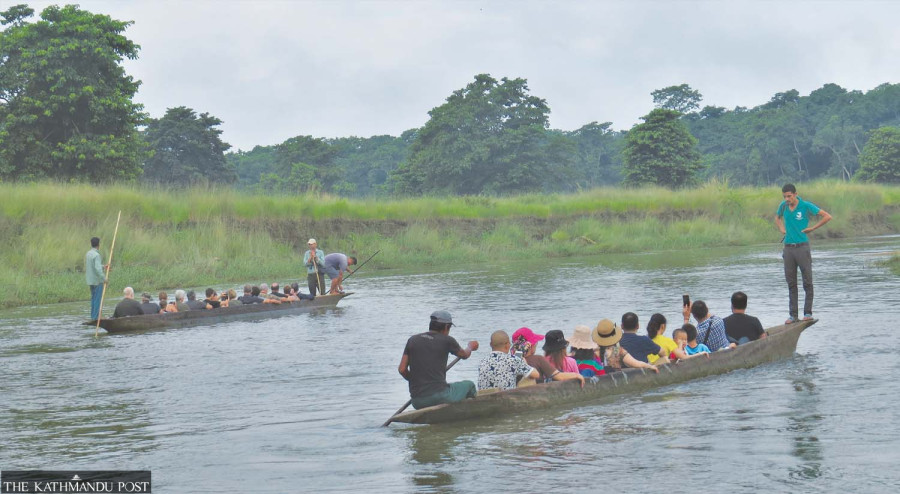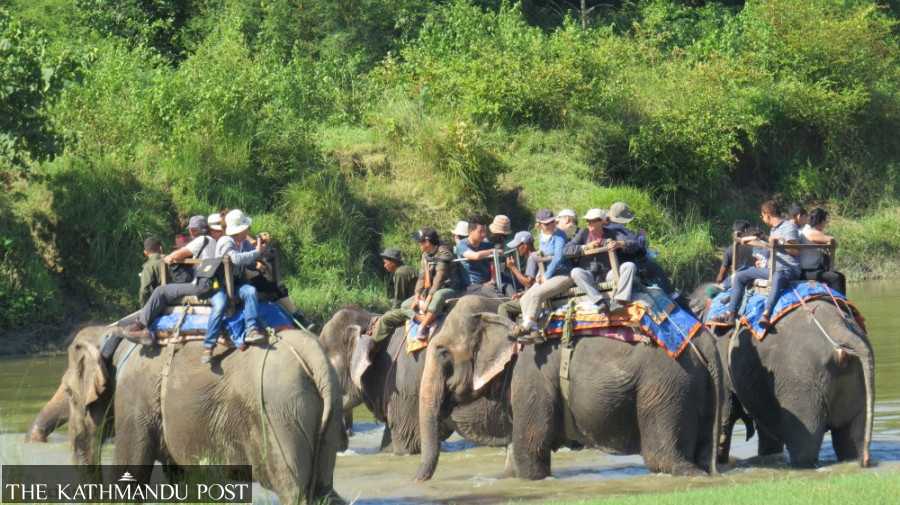Money
Chitwan National Park making strides in attracting domestic tourists
The country’s first national park has seen domestic tourism flourish with people from across Nepal visiting the park after Covid restrictions were lifted.
Ramesh Kumar Paudel
Chitwan National Park, Nepal’s first national park, received a record-high number of visitors in the last fiscal year that ended on July 16, as domestic safari goers swarmed the jungle glad to be freed of virus restrictions.
The park with rich biodiversity has received several international recognition for conservation and has over the years been gaining popularity as a safari destination too, thanks to the wildlife that calls the park their home.
The park which relies heavily on tourism revenue and the hundreds of people who depend on tourism for survival faced an unprecedented drought in tourism when the Covid pandemic hit Nepal two years ago.
Foreign tourists stopped coming to Chitwan after the Covid-19 pandemic which inadvertently put the livelihood and survival of man and animals both at risk.
However, domestic tourism flourished with people from across Nepal visiting the park after Covid restrictions were lifted. Out of the 190,450 tourists who visited the park in the last fiscal year, more than 155,671 were domestic visitors, says Ganesh Prasad Tiwari, information officer at the park. “It is the highest number of Nepali tourists to have visited the park to date,” he said.
Basu Bidari, former president of the Nature Guide Association, says the increase in the number of domestic tourists is a good sign “but conservation of the natural habitat of the wild animals should be given equal importance.”
The national park is home to tigers, one-horned rhinos, elephants, gharials, birds and more and the biggest draw among them all is the famed Royal Bengal tiger.
“Rhinos and spotted deer have become common sightings here in Chitwan. But sighting a tiger is on everyone’s itinerary. If you want to see a tiger, you have to be patient,” said Bidari.
Travel trade entrepreneurs say that domestic visitors come to the park on short trips and therefore very few have recounted tiger sightings. “But foreigners come to the park on extended trips. Most of the foreign visitors prolong their stay just to see the Royal Bengal tigers.”
Established in 1973, Chitwan National Park is the country’s first national park. Characterised by a thick tropical jungle, the national park conducts jungle tours on jeeps and on elephant backs, and also offers canoe rides on the crocodile-infested rivers to visitors.
The national park has not only contributed to boosting the tourism sector but has also played an important role to help the country achieve its goal of doubling the tiger population by 2022.
Of the 355 tigers in Nepal, the Chitwan National Park alone hosts 128, according to the latest census.
The tiger population has almost tripled in a decade. In 2010, there were 121 tigers in Nepal. The number rose to 198 in 2013 and 235 in 2018.
Similarly, of the 752 one-horned rhinos in the country, 694 are in Chitwan National Park, according to the nationwide rhino census made public last year.
The park is situated in South Central Nepal, about 146 kilometres away from Kathmandu.
Another 20 kilometres southeast lies Sauraha, the most famous, among 10 entry points to the park.

Doma Poudel, a tourist guide in Sauraha, said visitors, especially from Europe and the US, are more interested in spotting tigers.
The Bis Hajari Taal, Twenty thousand lake, a wetland area listed on the Ramsar sites is also located in the national park.
The park was identified as a safe destination for migratory birds in 2015.
“Around 651 species of birds can be found in Chitwan,” said Bidari, the former president of Bird Education Society in Sauraha. “The visitors, especially from Sweden, the United Kingdom and Denmark are bird enthusiasts.”
After tigers and elephants and birds, gharials are another draw of the park.
The Rapti and Narayani rivers are the habitats for critically endangered gharials, according to conservationists. In 2016, 198 gharials were found nationwide. Eighty-four were found in the Narayani river, 82 in Rapti river, 31 in the Babai river and one in Karnali river.
The Chitwan National Park was the second most popular safari destination after Africa, and the jungle resorts provided jobs to 3,000 persons including 60 elephant drivers before they were closed in 2012.
There were six resorts, namely Tiger Tops Jungle Lodge, Machan Wildlife Camp, Chitwan Jungle Lodge, Gaida Wildlife Camp, Island Jungle Resort, Hotel Narayani Safari and Temple Tiger Hotel. The jungle resort used to charge $400 per room per night inside the park.
The pioneer in jungle resorts, Tiger Tops Jungle Lodge, was founded by British tourism entrepreneur Jim Edwards in 1964, nine years before the park was established in 1973. The other resorts opened in the 1980s and 1990s.
Now, more than 300 resorts are located on the periphery of the national park.
“Tiger Tops established in Meghauli has been closed. It contributed a lot to promoting Chitwan’s wildlife tourism in the international arena,” said Ramprit Yadav, former conservation officer of the park.
The park was listed as a world heritage site by the United Nations Educational, Scientific and Cultural Organisation in 1984.
Besides wildlife, local cultural exhibits are a big draw for tourists. Indigenous communities like the Tharu and Kumal reside near the protected area. The opportunity to get a glimpse into their customs, traditions, lifestyle and music gives tourists an added incentive to visit the national park.
“While the park is mostly visited for wildlife tourism, the indigenous culture of the area also attracts the tourists,” said Ram Singh Gurung, administrative manager of the Tiger Tops Jungle Lodge, who has been with the lodge for more than three and a half decades.
Today there are more than 125 hotels near the national park catering now not only to foreign tourists but also to a growing number of domestic tourists.
A study carried out in the fiscal year 2017-18 had shown that tourists visiting Chitwan spend around Rs 1.8 billion in a year, said Bed Kumar Dhakal, then conservation officer at the park.
“There was only a tea shop and a house at Sauraha when I first came here more than five decades ago,” said Yadav, the former conservation officer.
“The Chitwan National Park should be promoted more aggressively as a wildlife safari destination,” said Yadav. “The conservation activities should be in top priority because without conservation, tourists won’t come.”




 16.24°C Kathmandu
16.24°C Kathmandu1.jpg)















